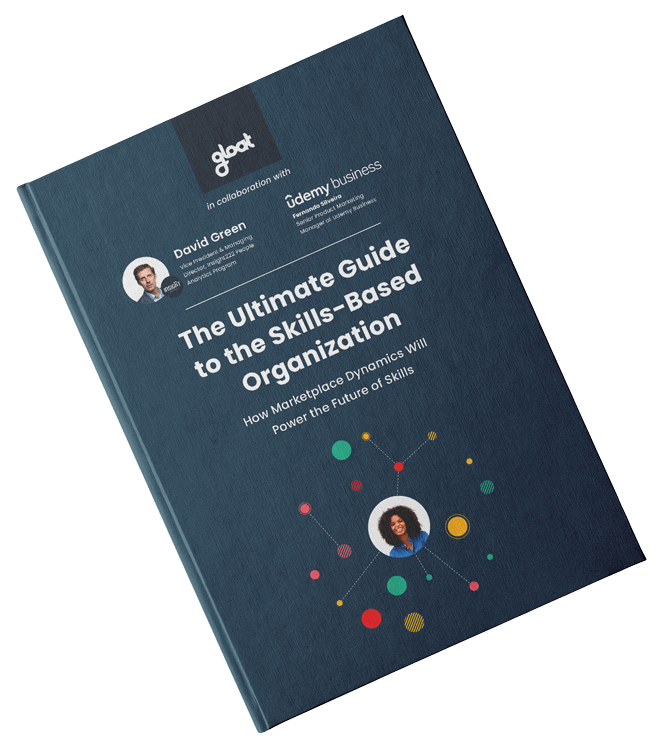Skills inventory: what it is and why HR needs it
Why a single destination for workforce capabilities is an HR essential

Leaders can’t rely on outdated tools and strategies and expect to deliver cutting-edge results. Yet, that’s exactly what some executives are doing when it comes to talent management.
While 90% of organizations are actively experimenting with skills-based strategies as a new approach to managing work and allocating resources, many businesses don’t have the systems in place to fully transition away from job-dominant operating models.
Skills inventories are one of the most powerful solutions companies can use to advance their workforce operations. By showcasing all of the capabilities within their workforce and identifying where knowledge gaps lie, skills inventories make it easier for HR teams to optimize their resourcing and talent investments.
What is a skills inventory?
A skills inventory is a documented list of employees’ skills, qualifications, and experiences, used by organizations to identify talent, plan workforce development, fill skill gaps. It helps HR teams align internal capabilities with business needs and improve succession planning.
Skills inventories can help HR professionals identify where critical skills sit within their organization, indicating where to invest in training and upskilling to overcome gaps, and where to prioritize future hiring needs.
Organizations use it to identify available talent, track skill gaps, and support workforce planning. It helps managers make informed decisions about training, promotions, and project assignments based on verified employee capabilities.
Why every HR team needs a skill inventory
As companies strive to transform into skills-based organizations, having a skills inventory will become a top priority. These solutions enable leaders to take a bird’s eye view of their workforce’s capabilities and identify who to move into new roles and opportunities.
Skills inventories also help HR executives craft upskilling and reskilling initiatives that align with the knowledge shortages their organizations are looking to overcome. Finally, having a complete skills inventory will help HR teams make informed strategic workforce planning decisions and ensure they’re not relying on external hiring when there’s someone within their organization who has the skills they’re looking for.
What a skills inventory framework enables
Skills inventories provide key value to set business and workforce objectives. Here’s what a skills inventory can do for your business:
Get a single view of all workforce skills
Traditionally, gaining a complete picture of workforce capabilities has been challenging because this information is often siloed between multiple HR systems. Manual inventories won’t suffice because employees are continuously learning new skills, causing the information they present to quickly become outdated. Fortunately, the rise of skills intelligence systems like Gloat’s Skills Foundation enables leaders to tap into a unified skills taxonomy that sheds light on workforce capabilities and updates in real time as employees hone new skills. Some of these systems also harmonize internal and third-party data sources to generate insights into which skills are trending and which are on the decline.
Assess employees’ skills
The most comprehensive skills inventories will go beyond cataloging capabilities by also including details about how proficient various employees are. Rather than relying solely on employees to self-report their competencies, leading skills intelligence platforms have robust AI capabilities to evaluate proficiency and include this detailed data within the skill inventory. This AI-centric approach enables the business to understand each employee’s years of experience and how skills were used. It also enhances any self-reporting with inferences from market and company data to build a more comprehensive and accurate skills view.
Tap critical talent fast
Once leaders have this database of employee skills, it’s easy to see which employees have the most in-demand skills and deploy talent where it’s needed most. When you need to move fast, skill inventories enable businesses to search by skill and apply cross-functional resources to the highest business priorities. Many companies enhance their use of skills inventories with talent marketplaces to align employees to open opportunities based on the skills they have and the knowledge they wish to build.
How to use a skills inventory for HR planning
With help from an AI-powered skills intelligence system, HR teams can upgrade the following talent management processes:
#1. Recruiting
A skills inventory can help leaders understand what skills their people have, what knowledge may be transferable from one role to another, and where the organization is lacking expertise that they may need to hire for. Without a skills inventory, HR teams may not know the skills their employees have and could overlook internal talent for roles and opportunities that need support, favoring more expensive contracting or recruiting processes.
#2. Training and development
Skills inventories can also help leaders identify where their workforce skills might be lacking, especially if this inventory evaluates proficiency in addition to depicting who has what skills. If HR leaders see that their workforce is missing specific capabilities, they can focus on devising training efforts and upskilling initiatives that build up this type of expertise.
#3. Talent mobility and succession planning
Succession planning is key for continuity and resilience but it’s almost impossible to do strategically without a skills inventory. Once leaders have a clear picture of their workforce’s capabilities, they can pinpoint employees who possess most of the skills needed to step into a future management role, as well as the skill gaps they’ll need to bridge to get there.
#4. Workforce planning and restructuring
To unlock the level of agility that the new world of work demands, HR teams should continuously think about ways to restructure teams and reallocate talent to respond to emerging challenges and shifting business needs. A skills inventory will make it easy to identify what talent should be moved where to respond to rapid changes in record time.
#5. Identify reskilling and upskilling opportunities
As the half-life of learned knowledge shrinks and AI changes the capabilities various jobs require, no employee can afford to let their skills stagnate. Instead, everyone must continuously develop new expertise in order to stay relevant and help their organization reach its overarching goals. By shedding light on the skills your workforce has and the potential knowledge gaps that are emerging, skills inventories enable leaders to pinpoint opportunities that will help employees build the knowledge they need to keep growing with their organizations.
#6. Performance management and career pathing
A skills inventory is invaluable for enhancing performance management and career pathing within an organization. By providing a detailed view of each employee’s skills and proficiency levels, HR teams can align performance evaluations with actual competencies and development needs. This alignment allows for more tailored feedback and goal-setting. Additionally, a well-maintained skills inventory helps in mapping out clear career paths for employees, identifying potential growth opportunities, and designing targeted development plans. This strategic approach ensures that employees receive the support they need to advance in their careers, while also aligning their growth with organizational objectives.
To learn more about the solutions and frameworks forward-thinking HR teams are harnessing, check out our guide to becoming a skills-based organization.





